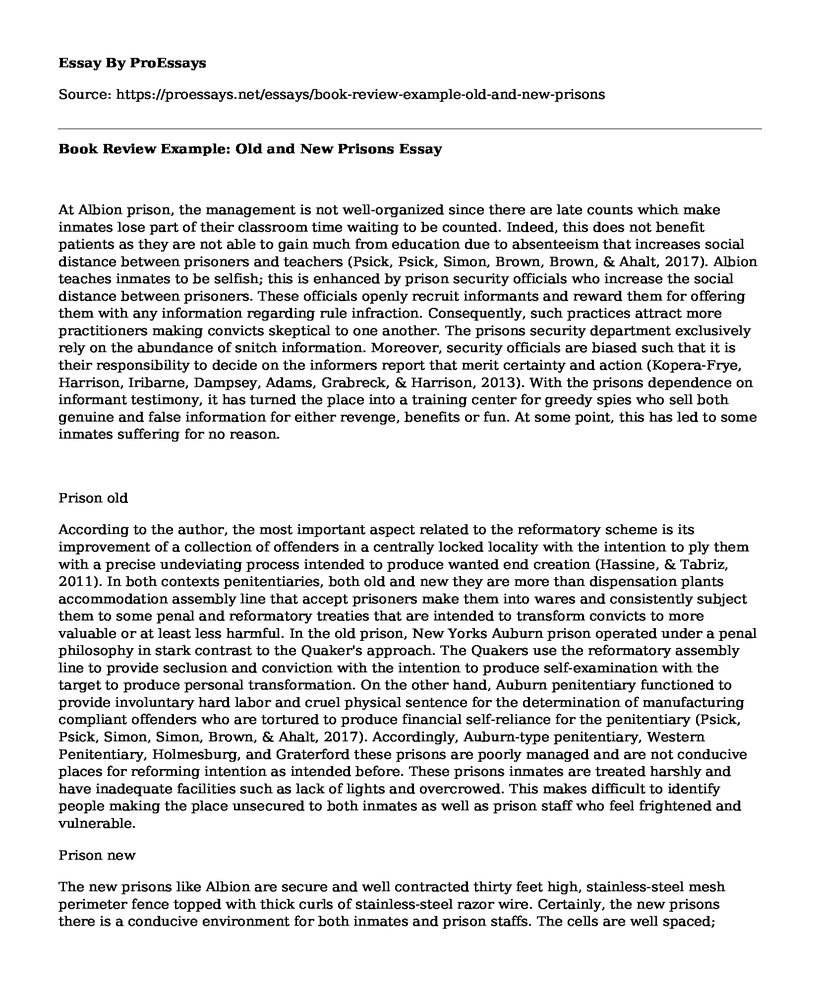At Albion prison, the management is not well-organized since there are late counts which make inmates lose part of their classroom time waiting to be counted. Indeed, this does not benefit patients as they are not able to gain much from education due to absenteeism that increases social distance between prisoners and teachers (Psick, Psick, Simon, Brown, Brown, & Ahalt, 2017). Albion teaches inmates to be selfish; this is enhanced by prison security officials who increase the social distance between prisoners. These officials openly recruit informants and reward them for offering them with any information regarding rule infraction. Consequently, such practices attract more practitioners making convicts skeptical to one another. The prisons security department exclusively rely on the abundance of snitch information. Moreover, security officials are biased such that it is their responsibility to decide on the informers report that merit certainty and action (Kopera-Frye, Harrison, Iribarne, Dampsey, Adams, Grabreck, & Harrison, 2013). With the prisons dependence on informant testimony, it has turned the place into a training center for greedy spies who sell both genuine and false information for either revenge, benefits or fun. At some point, this has led to some inmates suffering for no reason.
Prison old
According to the author, the most important aspect related to the reformatory scheme is its improvement of a collection of offenders in a centrally locked locality with the intention to ply them with a precise undeviating process intended to produce wanted end creation (Hassine, & Tabriz, 2011). In both contexts penitentiaries, both old and new they are more than dispensation plants accommodation assembly line that accept prisoners make them into wares and consistently subject them to some penal and reformatory treaties that are intended to transform convicts to more valuable or at least less harmful. In the old prison, New Yorks Auburn prison operated under a penal philosophy in stark contrast to the Quaker's approach. The Quakers use the reformatory assembly line to provide seclusion and conviction with the intention to produce self-examination with the target to produce personal transformation. On the other hand, Auburn penitentiary functioned to provide involuntary hard labor and cruel physical sentence for the determination of manufacturing compliant offenders who are tortured to produce financial self-reliance for the penitentiary (Psick, Psick, Simon, Simon, Brown, & Ahalt, 2017). Accordingly, Auburn-type penitentiary, Western Penitentiary, Holmesburg, and Graterford these prisons are poorly managed and are not conducive places for reforming intention as intended before. These prisons inmates are treated harshly and have inadequate facilities such as lack of lights and overcrowed. This makes difficult to identify people making the place unsecured to both inmates as well as prison staff who feel frightened and vulnerable.
Prison new
The new prisons like Albion are secure and well contracted thirty feet high, stainless-steel mesh perimeter fence topped with thick curls of stainless-steel razor wire. Certainly, the new prisons there is a conducive environment for both inmates and prison staffs. The cells are well spaced; buildings are climate-controlled, well-lit, spotlessly clean and color coordinated (Jewkes, 2013). There are security cameras all over, and there are no blind spots. Moreover, every housing unit is installed with bath stalls, washing facilities, a spacious day apartment, TV quarters, and big windowed lockups. Inmates can gain access to education and vocational training. Here the days program is well scheduled such that patients' activities follow a set program to avoid any confusion. The author says that Albion prison was like a college campus such that it became possible for him to learn warehouse (Kopera-Frye, Harrison, Iribarne, Dampsey, Adams, Grabreck, Harrison, 2013).
References
Hassine, V., & Tabriz, S. (2011). Life without Parole: Living and dying in prison today. Southwest Journal of Criminal Justice, 8, 2.
Jewkes, Y. (2013). On carceral space and agency. Carceral Spaces: Mobility and organization in imprisonment and migrant detention.
Kopera-Frye, K., Harrison, M. T., Iribarne, J., Dampsey, E., Adams, M., Grabreck, T. & Harrison, W. O. (2013). Veterans aging in place behind bars: a structured living program that works. Psychological services, 10(1), 79.
Psick, Z., Psick, Z., Simon, J., Simon, J., Brown, R., Brown, R. & Ahalt, C. (2017). Older and incarcerated: policy implications of aging prison populations. International Journal of Prisoner Health, 13(1), 57-63.
Cite this page
Book Review Example: Old and New Prisons. (2021, Apr 21). Retrieved from https://proessays.net/essays/book-review-example-old-and-new-prisons
If you are the original author of this essay and no longer wish to have it published on the ProEssays website, please click below to request its removal:
- Two Different Approaches to a Murder and What That Tells us About the 19th Century
- Restorative Justice Approach Essay
- Essay Sample on Rehabilitation as a Better Solution Instead of Sending to Prison
- High School Students Using Drugs - Research Paper
- Essay on Voters' Healthcare Priorities: ACA vs. HEART Ahead of 2020 Election
- DACA: Deferring Deportation for Immigrant Kids - Essay Sample
- Essay Example on Accessibility for People with Disabilities: A Global Challenge







